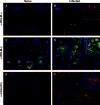Novel effector molecules in type 2 inflammation: lessons drawn from helminth infection and allergy
- PMID: 16849442
- PMCID: PMC1780267
- DOI: 10.4049/jimmunol.177.3.1393
Novel effector molecules in type 2 inflammation: lessons drawn from helminth infection and allergy
Abstract
Type 2 cytokine-induced inflammatory responses are critical components of the mucosal immune response required for host defense against helminth infection and are also responsible for the pathogenesis of many debilitating diseases including asthma, allergy, and forms of inflammatory bowel disease. Given the global prevalence of helminth infections, with an estimated two billion individuals infected worldwide, and the pandemic levels of asthma and allergy, with 30% of the population affected in North America, it is essential to define the molecules and pathways that underlie the protective or pathologic consequences of type 2 inflammation. In this review, we will focus on four families of proteins that are highly induced in helminth infection and allergy: 1) the arginases; 2) the resistin-like molecules; 3) the chitinase-like mammalian proteins; and 4) the intelectins. Here, we summarize what is known about their regulation and potential function in protecting against infection and/or exacerbating inflammation.
Figures



References
-
- Fort MM, Cheung J, Yen D, Li J, Zurawski SM, Lo S, Menon S, Clifford T, Hunte B, Lesley R, et al. IL-25 induces IL-4, IL-5, and IL-13 and Th2-associated pathologies in vivo. Immunity. 2001;15:985–995. - PubMed
-
- Finkelman FD, Shea-Donohue T, Morris SC, Gildea L, Strait R, Madden KB, Schopf L, Urban JF., Jr. Interleukin-4- and interleukin-13-mediated host protection against intestinal nematode parasites. Immunol. Rev. 2004;201:139–155. - PubMed
-
- Murphy KM, Reiner SL. The lineage decisions of helper T cells. Nat. Rev. Immunol. 2002;2:933–944. - PubMed
-
- Dillon SR, Sprecher C, Hammond A, Bilsborough J, Rosenfeld-Franklin M, Presnell SR, Haugen HS, Maurer M, Harder B, Johnston J, et al. Inter-leukin 31, a cytokine produced by activated T cells, induces dermatitis in mice. Nat. Immunol. 2004;5:752–760. - PubMed
-
- Schmitz J, Owyang A, Oldham E, Song Y, Murphy E, McClanahan TK, Zurawski G, Moshrefi M, Qin J, Li X, et al. IL-33, an interleukin-1-like cytokine that signals via the IL-1 receptor-related protein ST2 and induces T helper type 2-associated cytokines. Immunity. 2005;23:479–490. - PubMed
Publication types
MeSH terms
Substances
Grants and funding
LinkOut - more resources
Full Text Sources
Other Literature Sources
Medical

